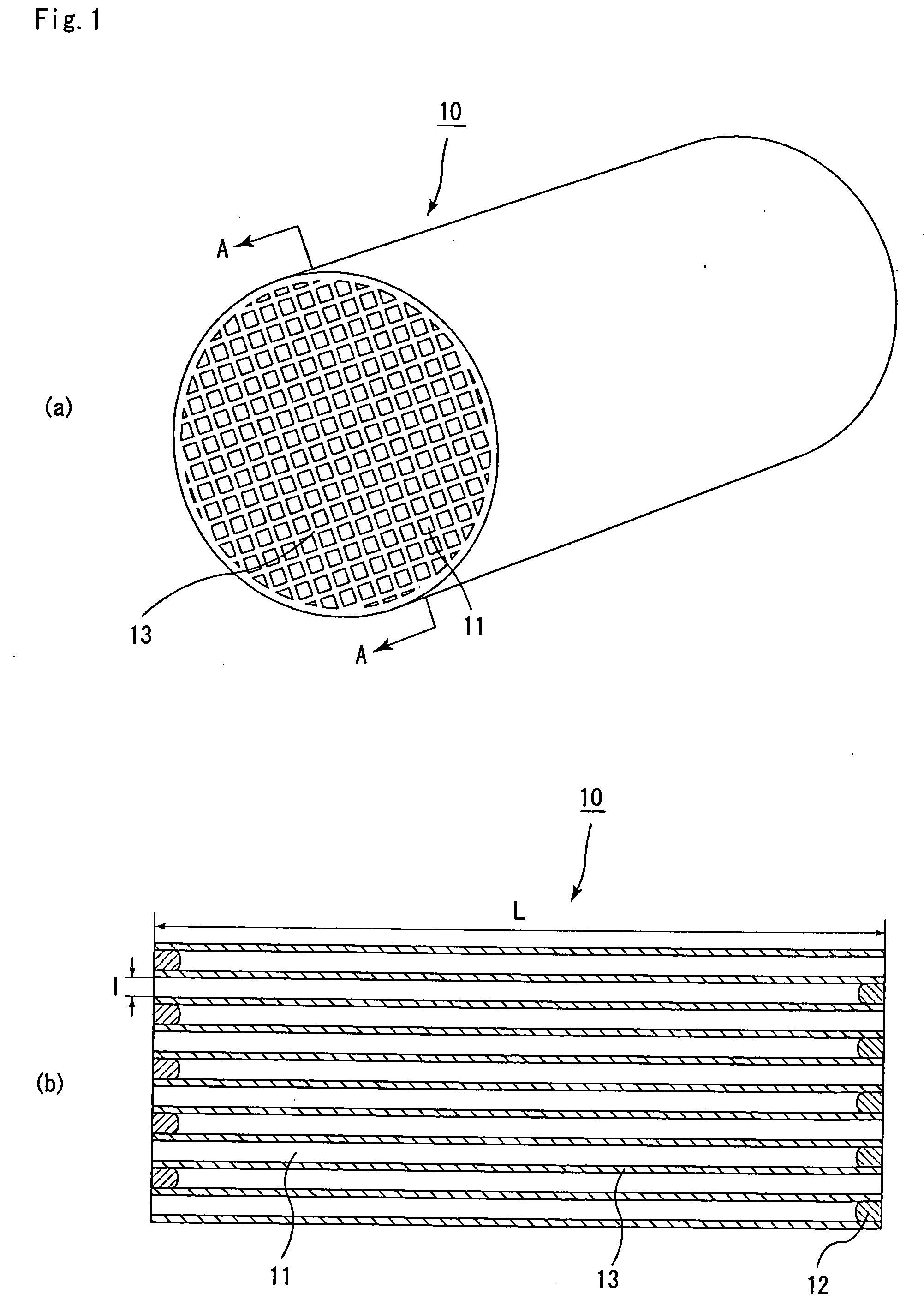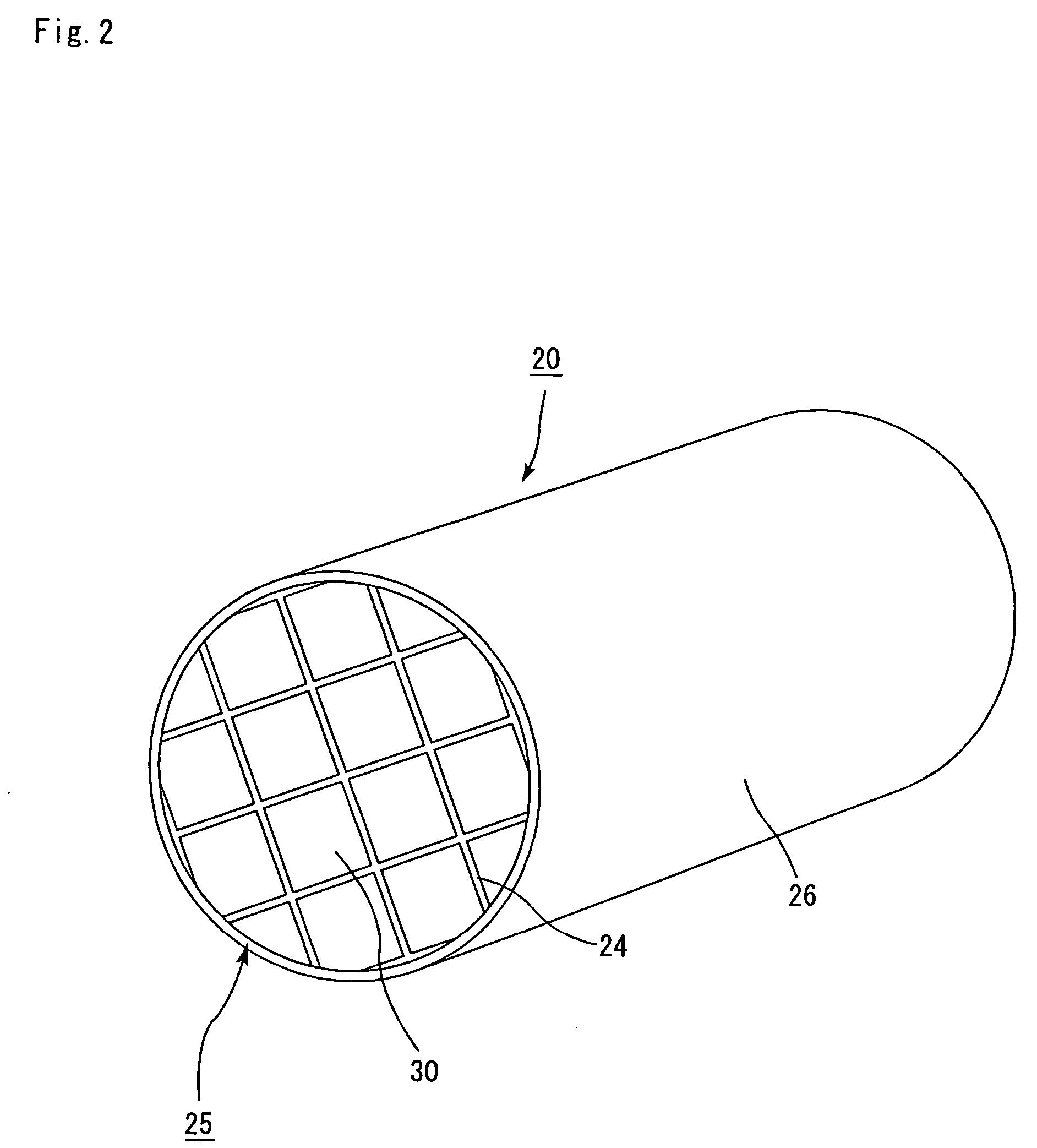Honeycomb filter for exhaust gas decontamination and exhaust gas decontamination apparatus
a technology of exhaust gas decontamination and honeycomb filter, which is applied in the direction of filtration separation, separation process, physical/chemical process catalyst, etc., can solve the problems of affecting the filtration effect, so as to achieve less susceptible to high initial pressure loss
- Summary
- Abstract
- Description
- Claims
- Application Information
AI Technical Summary
Benefits of technology
Problems solved by technology
Method used
Image
Examples
examples 21 to 24
[0286] The same processes as Examples 17 to 20 were carried out except that in the regenerating process of the honeycomb filter, the gas to be flown into the honeycomb filter was changed to an oxygen-nitrogen mixed gas having an oxygen concentration of 6%.
examples 25 and 26
, AND REFERENCE EXAMPLE 1
[0304] (1) Powder of α-type silicon carbide having an average particle size of 5 μm (60% by weight) and powder of β-type silicon carbide having an average particle size of 0.5 μm (40% by weight) were wet-mixed, and to 100 parts by weight of the resulting mixture were added and kneaded 5 parts by weight of an organic binder (methyl cellulose) and 10 parts by weight of water to obtain a material paste. Next, after a slight amount of a plasticizer and a lubricant had been added to the material paste and this had been further kneaded, the resulting material paste was extrusion-formed by using a die which has 0.1 μm in the surface roughness Ra of wall faces of thin pores directly made in contact with the material paste so that a raw formed body in which multiple of through holes were arranged in paralled with one another in the length direction with partition wall interposed therebetween was manufactured.
[0305] Next, after the above-mentioned raw formed body had...
examples 29 and 30
, AND REFERENCE EXAMPLE 2
[0319] (1) Powder of α-type silicon carbide having an average particle size of 5 μm (60% by weight) and powder of β-type silicon carbide having an average particle size of 0.5 μm (40% by weight) were wet-mixed, and to 100 parts by weight of the resulting mixture were added and kneaded 5 parts by weight of an organic binder (methyl cellulose) and 10 parts by weight of water to obtain a material paste. Next, after a slight amount of a plasticizer and a lubricant had been added to the material paste and this had been further kneaded, the resulting material paste was extrusion-formed by using a die which has 0.1 μm in the surface roughness Ra of wall faces of thin pores directly made in contact with the material paste so that a raw formed body in which multiple of through holes were arranged in paralled with one another in the length direction with partition wall interposed therebetween was manufactured.
[0320] Next, after the above-mentioned raw formed body had...
PUM
| Property | Measurement | Unit |
|---|---|---|
| Ra | aaaaa | aaaaa |
| surface roughness Ra | aaaaa | aaaaa |
| surface roughness Ra | aaaaa | aaaaa |
Abstract
Description
Claims
Application Information
 Login to View More
Login to View More - R&D
- Intellectual Property
- Life Sciences
- Materials
- Tech Scout
- Unparalleled Data Quality
- Higher Quality Content
- 60% Fewer Hallucinations
Browse by: Latest US Patents, China's latest patents, Technical Efficacy Thesaurus, Application Domain, Technology Topic, Popular Technical Reports.
© 2025 PatSnap. All rights reserved.Legal|Privacy policy|Modern Slavery Act Transparency Statement|Sitemap|About US| Contact US: help@patsnap.com



